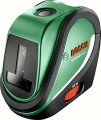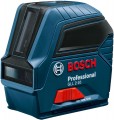Accuracy
Accuracy is described as the maximum deviation from the true value of the measured parameter, which the device can give if all the rules for its operation and the corresponding measurements are observed. In both rangefinders and levels, this parameter is usually designated for a certain distance — for example, 3 mm at 30 m; but even for one manufacturer, these "control" distances may be different. Therefore, in our catalog, the accuracy of all devices is recalculated for 1 m distance; with such a record, for the example above, it will be 3/30 \u003d 0.1 mm / m. This makes it easier to compare different models with each other.
It is also worth mentioning that the meaning of the "accuracy" parameter for different types of measuring instruments (see "Type") will be different. For optical levels, it is described in the "SKP" paragraph above. For laser levels of all types, accuracy is the maximum deviation of the mark from the true horizontal (or vertical, if such a function is provided), and for the horizontal, we can talk about both moving the mark up / down and turning it. In rangefinders, this characteristic describes the maximum difference (both in "plus" and "minus") between the readings of the device and the actual distance to the object.
Anyway, the smaller the error, the better; on the other hand, accuracy significantly affects the price of the device. Therefore, it is necessary to choose a specific model for this parameter, taking into account the...specifics of the planned work. For example, for a relatively simple repair in a residential apartment, a high-precision tool is unlikely to be required; and recommendations for more complex tasks can be found in specialized sources, ranging from expert advice to official instructions.
Operating temperature
The temperature range at which the device is guaranteed to work for a sufficiently long time without failures, breakdowns and exceeding the measurement error specified in the characteristics. Note that we are talking primarily about the temperature of the device case, and it depends not only on the ambient temperature — for example, a tool left in the sun can overheat even in fairly cool weather.
In general, you should pay attention to this parameter when you are looking for a model for working outdoors, in unheated rooms and other places with conditions that are significantly different from indoor ones; in the first case, it makes sense to also make sure that there is dust and water protection (see "Protection class"). On the other hand, even relatively simple and "myopic" levels / rangefinders usually tolerate both heat and cold quite well.
Tripod thread
The standard size of the thread used to mount the level/rangefinder on a tripod (if available). This option can be useful if you already have a surveying tripod that you want to use with the tool.
The most popular options in modern devices are 1/4" and 5/8". It is worth noting that 1/4" is a standard size for
photographic equipment - accordingly, levels with such a thread can be installed even on ordinary
photographic tripods.
Auto power off
The ability
to automatically turn off the device after a certain time. This function is found in those types of measuring instruments that require power for operation — first of all, we are talking about laser rangefinders, however, this list may also include levels (see "Type"), both laser and optical with additional digital modules . The main purpose of auto-shutdown is to save electricity: after all, almost all such devices have autonomous power sources (see "Power"), the charge of which is not infinite. Forgetting to turn off the device, you may encounter an unpleasant situation: the batteries are dead, but there are no fresh ones at hand; auto-off prevents these situations and generally increases the operating time without changing batteries or recharging the battery. In addition, this feature is also useful from a safety point of view: automatic laser shutdown reduces the likelihood that its beam will accidentally fall into the eyes of someone around (including a forgetful operator).
In some models, auto-shutdown works on the entire electronics, in others it may be possible to turn off the laser first (as the most energy-intensive and unsafe part), and only after a while — all other electronic circuits.
Auto power off
The time after which the device turns off by itself completely if the user does not perform any action.
See above for more information on auto power off; and his time has a double meaning. On the one hand, if this time is short, then the idle time of the device will be minimal, which helps to save energy. On the other hand, too frequent auto-shutdown (with subsequent switching on for work) is also undesirable — it increases the wear of components and reduces the resource, and it is not always convenient for the user. So manufacturers choose the time, taking into account the balance between these moments, as well as the general class and purpose of the device. So, in some rangefinders, this indicator does not even reach a minute, although in most such devices it is in the range from 3 to 8 minutes; and in some professional devices (primarily levels), the auto-off time can be 30 minutes or more (up to 3 hours).
Beam angle (vertical)
The sweep angle in the vertical plane provided by the level emitter. If there are several such radiators (for example, on both sides of the case), this parameter is given for each of them separately.
The sweep angle is, in fact, the coverage angle, that is, the width of the sector captured by the emitter when the line is formed. The wider this angle, the more convenient the device is to use, the lower the likelihood that the device will have to be moved up and down to build a line. On the other hand, a larger sweep angle (at the same range) requires more power — and this, accordingly, affects the cost and power consumption.
Beam angle (horizontal)
The sweep angle in the horizontal plane provided by the level emitter. If there are several emitters, their total coverage angle is indicated here; a typical example of such devices are models for full 360 °, not related to rotation.
Actually, all rotary devices, by definition, provide a coverage of 360 °. Therefore, it is worth paying attention to this parameter in cases where we are talking about more traditional laser levels. And here it is worth considering that a larger coverage angle, on the one hand, can provide additional convenience, on the other hand, it increases the price and power consumption of the device. So when choosing, you should proceed from real needs; detailed recommendations on this subject can be found in special sources.
Point projections
The number of individual points projected by the laser tool — rangefinder or level, see "Type" — when working. In the first case, one
point projection is standardly provided — more is simply not required to measure distances. In levels, there can be several points, and some models do not have planar projections at all and work only with points. This format may not be as convenient as displaying lines; at the same time, with the same laser power, dot marks shine brighter and are more visible, especially at long distances. In addition, there are certain types of work for which point projection is considered optimal — for example, laying sewers, determining the locations for two holes in opposite walls, etc.
Zenith
Zenith in this case is called a point projection directed vertically upwards.
By itself, such a projection can be useful, for example, if you need to make holes in several floors, located strictly one above the other. It is enough to point the "anti-aircraft" laser at the hole located directly above it — and the mark from the beam that passed through this hole will indicate the point for the hole on the next floor. And if the device also has the nadir function (see below), then the combination of these functions will be very convenient for marking the floor and ceiling at the same time — for racks, partitions, etc.: marks from the zenith and nadir are located strictly one above the other.

